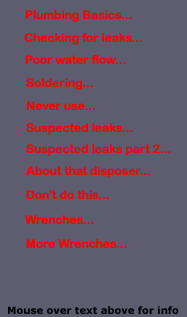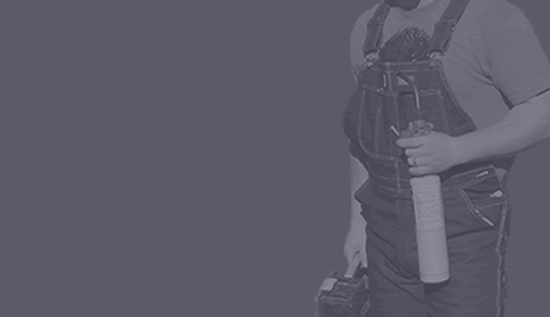





* When checking for known leaks find the wet area with your hand and follow it up until you feel no wetness. Water on the floor usually started somewhere else!
* If water comes out strong then trickles out it usually means the pipes are undersized or clogged. If the water just comes out slow from the start and you have checked all the aerators and angle stops for sediment, low pressure acompanied by small pipe size is the culprit. If your on a well try cranking up the hi/low pressure setting at the pump. If your still unhappy it may be time for a repipe!
* To solder...clean the pipe and fittings shiny... flux both... heat only the fittings and go all around with the torch... apply the solder till it flows into the joint... remove the heat and continue applying solder until it stops flowing ... then add more heat.If you’re trying to solder a pipe with water in it, let it run out as much as possible. Then
Smoosh some white bread into a tight dough ball and shove it into the pipe about 1 1/2 to
2 Inches (use the eraser end of a pencil or some other blunt instrument). This will stop the water long enough to solder it.
* Never use caulking for drains in sinks or lavys, only putty... On angle stop ferrels and angle stop threads use heat proof plumbers grease before tightening... Never put pipe dope on female threads only male... Never use plumbers putty on marble or granite... Always use primer and glue on PVC...Always flux the pipe and fittings when soldering.
* If your water bill is high and you suspect a leak, look at the triangle or the sweep hand on your water meter. In most cases, if you have a leak, they will be moving. Next (to isolate where the leak is), shut off the supply valve for your house. (it’s usually on the outside, on a pipe coming out of the ground and going into your house.) Turn it clockwise until it stops. If no water runs in your house when you turn a fixture on, you have the right valve. Next look at the meter again. If it is still moving the leak is in the service pipe coming from the meter to your house. If it’s not moving its inside someplace. If it’s outside dig it up and replace the pipe.
If the leak turns out to be inside; Shut off the supply stops under all your toilets and turn the house supply back on. Check the meter again. If it’s stopped the
internal parts of one of your toilets is defective and should be replaced. If it hasn't stopped and you see
no dripping faucets, check under the house for dripping water... and probably get ready to call a plumber! One final note; Sometimes the flapper in the toilet can be worn. If this is the case the water will run for a while then stop for a while then start again. Use dye pellets in the tank to check.
When you turn on the disposer make sure the water is running well
Never fill the disposer with waste before turning it on. Fill it half way at most.
Things not to put in your disposer:
.................................................Artichoke leaves
.................................................Potato peels
.................................................Coffee grounds
.................................................Tea Bags
.................................................Cigarette butts
.................................................Corn cobs
.................................................Husks of any kind
.................................................Any fibrous vegetable
.................................................Most bones
.................................................Anything non food or not biodegradable
.................................................Grease (no drain should get this)
.................................................Some say: Egg shells
...................................................................Pasta and rice
What not to do:
1. Hire a plumber to do work without understanding precisely what he plans to do.
2. Throw disposable diapers in toilet.
3. Pour hot water into toilet. It could crack the bowl.
4. Run the dishwasher if disposer is full of food waste
5. Use drain cleaners containing lye.
6. Let children play in bathroom with small toys
7. Plant trees or large shrubs over sewer lines
8. Dig deep holes or trenches in your yard before locating water, gas, and sewer lines
9. Place cornhusks, artichokes, onionskins, celery, or other high-fiber material in a disposer.
10. Keep wastebaskets under sinks. Bumping drain pipes cause leaks.
11. Throw sanitary napkins in toilet.
12. Pour fats or cooking oils into your sink
13. Hang a knick-knack shelf over your toilet.
Your home's plumbing actually involves several systems that work separately and, in some cases, together. Water is delivered to your home under pressure through the water supply system--galvanized steel or copper pipes that carry it to faucets, plumbing fixtures, outdoor hose-bibbs, sprinklers and the like.
Drain and waste plumbing is not under pressure like the supply system--gravity is the only force that moves water and waste to the sewer or septic system. Vent piping is coupled with the drain and waste to exhaust sewer gasses (normally out the roof) and to allow pressure equalization so drains can drain.
Gas piping is totally separate from the water system, but may utilizes pipes that look similar to water supply pipes. Gas pipes deliver natural gas from your utility to gas-fired appliances.
Pipe Wrench:
As the name implies; use it on pipes. Don't use on finished surface's.
Chain Pipe Wrench:
Good for irregular shapes. As with a regular pipe wrench marring will occur
Strap Wrench:
Used on finished surfaces. Won't scratch or damage finishes!
Basin Wrench:
Almost like a pipe wrench on a stick. Great for hard to get to areas (a must have).
Spud Wrench:
Big flat straight jawed wrench. Like a mechanics open end wrench. Won't mar surfaces.Some are adjustable.
Seat Wrench:
For removing seats in faucets and valves. The seat is the thing the washer pushes against to stop the water flow in faucets and valves.
PO Plug Wrench:
For removing drains in lavys.
Water Pump Pliers or Channel Lock Pliers:
Used to loosen sink strainer jam nuts or grip flush valve jam nuts. Will mar surfaces.
Packing Nut Socket Wrenches:
Usually comes in a set of 5. They are essentially vary big deep well sockets used for removing stems assemblies from tubs or showers faucets.
Handle pullers:
Not a wrench exactly. This is used to pull stubborn handles off of stems. Once pulled, use the packing nut socket wrenches to remove the stem assembly.
 |
 |
||||||||||||||||||
 |
 |
||||||||||||||||||
 |
 |
||||||||||||||||||